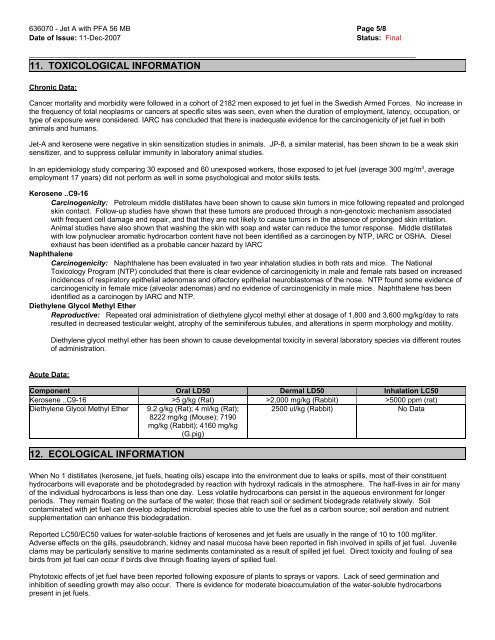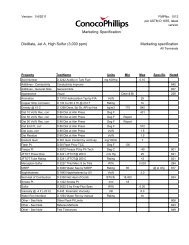Jet A with PFA 56 MB - Phillips 66 Aviation
Jet A with PFA 56 MB - Phillips 66 Aviation
Jet A with PFA 56 MB - Phillips 66 Aviation
You also want an ePaper? Increase the reach of your titles
YUMPU automatically turns print PDFs into web optimized ePapers that Google loves.
636070 - <strong>Jet</strong> A <strong>with</strong> <strong>PFA</strong> <strong>56</strong> <strong>MB</strong><br />
Date of Issue: 11-Dec-2007<br />
Page 5/8<br />
Status: Final<br />
________________________________________________________________________________________________<br />
11. TOXICOLOGICAL INFORMATION<br />
Chronic Data:<br />
Cancer mortality and morbidity were followed in a cohort of 2182 men exposed to jet fuel in the Swedish Armed Forces. No increase in<br />
the frequency of total neoplasms or cancers at specific sites was seen, even when the duration of employment, latency, occupation, or<br />
type of exposure were considered. IARC has concluded that there is inadequate evidence for the carcinogenicity of jet fuel in both<br />
animals and humans.<br />
<strong>Jet</strong>-A and kerosene were negative in skin sensitization studies in animals. JP-8, a similar material, has been shown to be a weak skin<br />
sensitizer, and to suppress cellular immunity in laboratory animal studies.<br />
In an epidemiology study comparing 30 exposed and 60 unexposed workers, those exposed to jet fuel (average 300 mg/m 3 , average<br />
employment 17 years) did not perform as well in some psychological and motor skills tests.<br />
Kerosene ..C9-16<br />
Carcinogenicity: Petroleum middle distillates have been shown to cause skin tumors in mice following repeated and prolonged<br />
skin contact. Follow-up studies have shown that these tumors are produced through a non-genotoxic mechanism associated<br />
<strong>with</strong> frequent cell damage and repair, and that they are not likely to cause tumors in the absence of prolonged skin irritation.<br />
Animal studies have also shown that washing the skin <strong>with</strong> soap and water can reduce the tumor response. Middle distillates<br />
<strong>with</strong> low polynuclear aromatic hydrocarbon content have not been identified as a carcinogen by NTP, IARC or OSHA. Diesel<br />
exhaust has been identified as a probable cancer hazard by IARC<br />
Naphthalene<br />
Carcinogenicity: Naphthalene has been evaluated in two year inhalation studies in both rats and mice. The National<br />
Toxicology Program (NTP) concluded that there is clear evidence of carcinogenicity in male and female rats based on increased<br />
incidences of respiratory epithelial adenomas and olfactory epithelial neuroblastomas of the nose. NTP found some evidence of<br />
carcinogenicity in female mice (alveolar adenomas) and no evidence of carcinogenicity in male mice. Naphthalene has been<br />
identified as a carcinogen by IARC and NTP.<br />
Diethylene Glycol Methyl Ether<br />
Reproductive: Repeated oral administration of diethylene glycol methyl ether at dosage of 1,800 and 3,600 mg/kg/day to rats<br />
resulted in decreased testicular weight, atrophy of the seminiferous tubules, and alterations in sperm morphology and motility.<br />
Diethylene glycol methyl ether has been shown to cause developmental toxicity in several laboratory species via different routes<br />
of administration.<br />
Acute Data:<br />
Component Oral LD50 Dermal LD50 Inhalation LC50<br />
Kerosene ..C9-16 >5 g/kg (Rat) >2,000 mg/kg (Rabbit) >5000 ppm (rat)<br />
Diethylene Glycol Methyl Ether 9.2 g/kg (Rat); 4 ml/kg (Rat);<br />
8222 mg/kg (Mouse); 7190<br />
mg/kg (Rabbit); 4160 mg/kg<br />
(G.pig)<br />
2500 ul/kg (Rabbit) No Data<br />
12. ECOLOGICAL INFORMATION<br />
When No 1 distillates (kerosene, jet fuels, heating oils) escape into the environment due to leaks or spills, most of their constituent<br />
hydrocarbons will evaporate and be photodegraded by reaction <strong>with</strong> hydroxyl radicals in the atmosphere. The half-lives in air for many<br />
of the individual hydrocarbons is less than one day. Less volatile hydrocarbons can persist in the aqueous environment for longer<br />
periods. They remain floating on the surface of the water; those that reach soil or sediment biodegrade relatively slowly. Soil<br />
contaminated <strong>with</strong> jet fuel can develop adapted microbial species able to use the fuel as a carbon source; soil aeration and nutrient<br />
supplementation can enhance this biodegradation.<br />
Reported LC50/EC50 values for water-soluble fractions of kerosenes and jet fuels are usually in the range of 10 to 100 mg/liter.<br />
Adverse effects on the gills, pseudobranch, kidney and nasal mucosa have been reported in fish involved in spills of jet fuel. Juvenile<br />
clams may be particularly sensitive to marine sediments contaminated as a result of spilled jet fuel. Direct toxicity and fouling of sea<br />
birds from jet fuel can occur if birds dive through floating layers of spilled fuel.<br />
Phytotoxic effects of jet fuel have been reported following exposure of plants to sprays or vapors. Lack of seed germination and<br />
inhibition of seedling growth may also occur. There is evidence for moderate bioaccumulation of the water-soluble hydrocarbons<br />
present in jet fuels.




